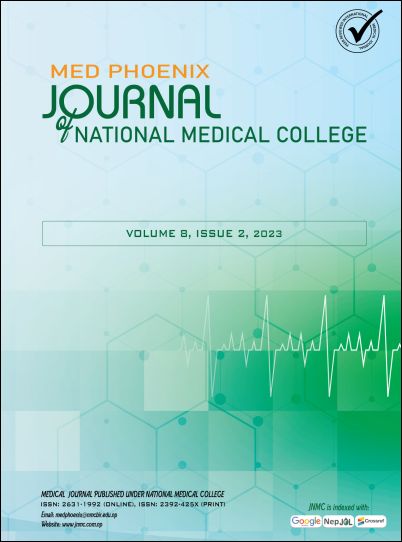Superficialization of the Basilic Vein in Brachiobasilic Arteriovenous Fistula: An Alternative Vascular Access for Hemodialysis- A Single Center Experience
DOI:
https://doi.org/10.3126/medphoenix.v8i2.61824Keywords:
Arteriovenous Fistula, Brachiobasilic Fistula, Hemodialysis AccessAbstract
Introduction: The use of basilic vein to create brachiobasilic arteriovenous fistula (BBAVF) is the vascular access option of choice for hemodialysis when cephalic veins are not available. To create BBAVF, the basilic vein should be superficialized and lateralized. The study aims to highlight the outcome and morbidity of BBAVF at the tertiary referral center and aims to improve the results of the procedure in patients with chronic renal failure.
Materials and Methods: This is prospective, descriptive study conducted at College of Medical Sciences Teaching Hospital from January 2019 to December 2022.The demographic data, morbidities, results were analyzed using the Statistical Package for Social Sciences (SPSS) version 23.0 (SPSS).
Results: We evaluated outcome of total forty patients who underwent BBAVF with transposition of basilic vein. The mean age of patients was 61 ± 10.85 years and male:female ratio was 2.07:1. The mean size of basilic vein was 3.05 ± 0.84mm and brachial artery was 4.11 ± 0.99mm. The most common co-morbidities in this study was Diabetes Mellitus and hypertension both was present in 52.5% of patients, only hypertension in 27.5%, only Diabetes Mellitus in 5%, HTN with PVD in 2.5% and HTN, Diabetes Mellitus with PVD in 2.5% of patients. The postoperative complications were bleeding in 25% (10), infection 10% (4), primary failure 7.5% (3), pseudoaneurysm 5% (2), and oedema 7.5% (3).Total 82.5% (33) of cases were able to start dialysis in 45 days. The failure rate was 12.5% (5) due to thrombosis and pseudoaneurysm.
Conclusion: BBAVF is a suitable option for vascular access in patients with failed previous AVF or patients with small cephalic vein. Relocation of basilic vein for AVF is feasible, safe and with good patency and complication rates are acceptable.
Downloads
Downloads
Published
How to Cite
Issue
Section
License
Copyright (c) 2023 Med Phoenix

This work is licensed under a Creative Commons Attribution 4.0 International License.
This license enables reusers to distribute, remix, adapt, and build upon the material in any medium or format, so long as attribution is given to the creator.
Copyright on any research article is transferred in full to MED PHOENIX upon publication. The copyright transfer includes the right to reproduce and distribute the article in any form of reproduction (printing, electronic media or any other form).




